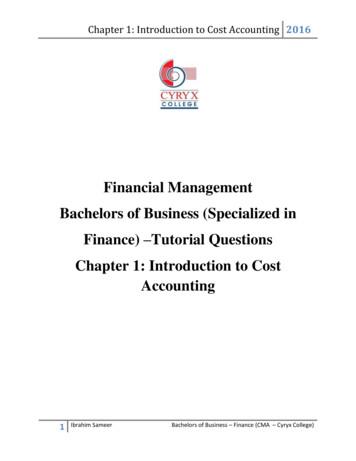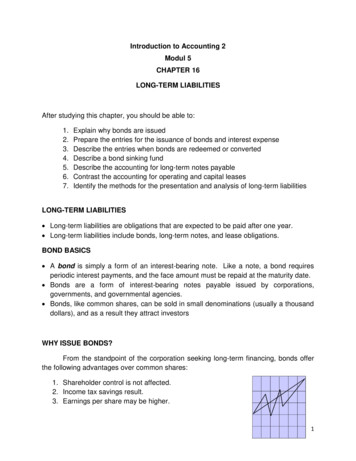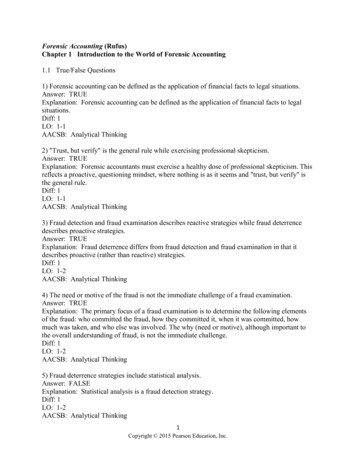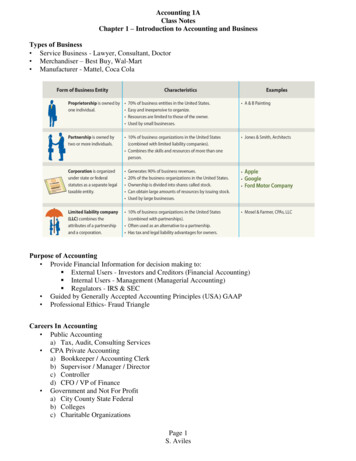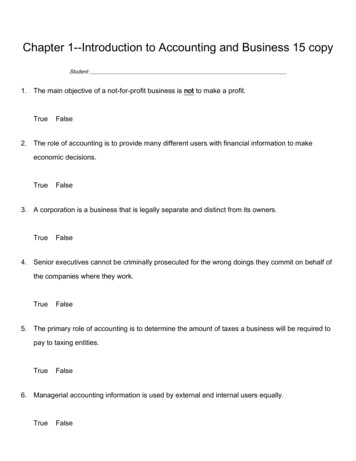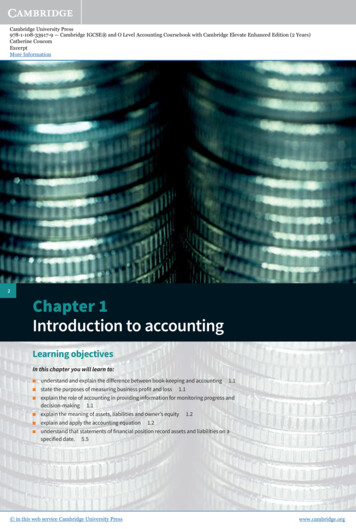
Transcription
Cambridge University Press978-1-108-33917-9 — Cambridge IGCSE and O Level Accounting Coursebook with Cambridge Elevate Enhanced Edition (2 Years)Catherine CoucomExcerptMore Information2Chapter 1Introduction to accountingLearning objectivesIn this chapter you will learn to: understand and explain the difference between book-keeping and accounting 1.1state the purposes of measuring business profit and loss 1.1explain the role of accounting in providing information for monitoring progress anddecision-making 1.1explain the meaning of assets, liabilities and owner’s equity 1.2explain and apply the accounting equation 1.2understand that statements of financial position record assets and liabilities on aspecified date. 5.522 in this web service Cambridge University Presswww.cambridge.org
Cambridge University Press978-1-108-33917-9 — Cambridge IGCSE and O Level Accounting Coursebook with Cambridge Elevate Enhanced Edition (2 Years)Catherine CoucomExcerptMore InformationChapter 1: Introduction to accounting1.1 IntroductionAccounting is regarded as the language of business. Accounting can be divided intotwo sections:Book-keepingKEY TERMSBook-keeping is a process of detailed recording of all the financial transactions of abusiness. It is necessary for even the smallest business to make a record of every transactionwhich affects the business. If the records are not maintained, it is likely that somethingwill be forgotten or overlooked. The basis of maintaining these detailed records is doubleentry book-keeping. The actual records maintained by one business may vary from thosemaintained by another business because each business is different. However, all businessesapply the same principles while maintaining double entry records.Book-keeping is thedetailed recordingof all the financialtransactions of abusiness.AccountingAccounting uses the book-keeping records to prepare financial statements at regularintervals. The owner of a business needs to know whether the business is making a profit ora loss. Periodically (often at yearly intervals), an income statement is drawn up. This showsthe calculation of the profit or loss earned by the business. If the business has earned a profitthen the owner is receiving a return on his investment and funds are available for expandingor improving the business. However, if the business has made a loss then it may eventuallyclose down as the owner is not receiving any return on his investment and funds are notavailable for running or maintaining the business.You can now answer Question 1 at the end of this chapter.The owner of the business also needs to know the financial position at regular intervals soa statement of financial position is prepared. This shows what the business owns andwhat is owing to it, its assets; and what the business owes, its liabilities. The term financialstatements is often used as a collective name for an income statement and a statement offinancial position.Accounting is usingbook-keeping recordsto prepare financialstatements and to assistin decision-making.A statement offinancial positionshows the assets andliabilities of a businesson a certain date.3LINKYou will learn moreabout financialstatements in Chapters8 and 9.The progress of the business can be measured by comparing the financial statements of oneyear with those of previous years, or with those of other similar businesses. The calculation ofvarious accounting ratios is used to measure the relationship between figures within a set offinancial statements. These are also useful for comparison purposes.The information provided by the financial statements shows the owner of the business whathas happened during a certain period of time and helps in monitoring the progress of thebusiness. The plans for the future development of the business are also based on thesefinancial statements.TEST YOURSELF 1.11 Define the term book-keeping.2 Define the term accounting.3 State two reasons why it is necessary to prepare financial statements at regular intervals.4 State what is included in the term financial statements. in this web service Cambridge University Presswww.cambridge.org
Cambridge University Press978-1-108-33917-9 — Cambridge IGCSE and O Level Accounting Coursebook with Cambridge Elevate Enhanced Edition (2 Years)Catherine CoucomExcerptMore InformationCambridge IGCSE and O Level AccountingLINK1.2 Assets, liabilities and capitalYou will learn moreabout assets andliabilities in Chapter 9.It is important to remember that the accounting records of a business relate only to thebusiness. From an accounting viewpoint, the owner of that business is regarded as beingcompletely separate from the business.KEY TERMSCapital is the totalresources providedby the owner andrepresents what thebusiness owes theowner.Assets representanything owed by orowing to the business.Liabilities representanything owed by thebusiness.LINK4You will learn aboutthe accounting recordsof partnerships andlimited companies inChapters 19 and 21.When a person decides to start a business he will have to provide the necessary funds(resources). This is often in the form of monetary funds, but may consist of buildings, motors,goods and so on. Any resources provided by the owner of the business are known as capital.This represents the amount owed by the business to the owner of that business.Once the business is formed and capital introduced, the business will own the money orother items provided by the owner. Things owned by the business (or owed to the business)are regarded as the resources of the business or the assets of the business.In addition to the owner, other people may also provide assets to the business. The amountowed by the business to these people is known as liabilities.TIPAnything provided for a business by the owner represents capital. This is not necessarily in theform of money.Many businesses are set up and operated by one person. These are known as sole traders.The early chapters in this book cover accounts maintained by sole traders.TEST YOURSELF 1.21 Define each of the following terms.a assets b liabilitiesc capital1.3 The accounting equationLike any other mathematical equation, the two sides of the equation will always be equal.The formula for this equation is:Assets Capital Liabilities.Capital is sometimes referred to as owner’s equity. So the previous equation can also bewritten as:Assets Owner’s equity Liabilities.TIPIf you know twoelements of theaccounting equationyou can easily calculatethe third element.Like any mathematical equation, the accounting equation can be used to find any one of thethree elements if the other two are present.This equation illustrates that the assets of a business (the resources used by a business)are always equal to the liabilities and capital of a business (the resources provided for thebusiness by others). The assets represent how the resources are used by the business andthe liabilities and capital represent where these resources come from. in this web service Cambridge University Presswww.cambridge.org
Cambridge University Press978-1-108-33917-9 — Cambridge IGCSE and O Level Accounting Coursebook with Cambridge Elevate Enhanced Edition (2 Years)Catherine CoucomExcerptMore InformationChapter 1: Introduction to accountingWalkthrough 1.120–7January 1 Leena set up a business to trade under the name of The Dress Shop. She openeda business bank account and paid in 20 000 as capital.2 The business purchased premises, 15 000, and paid by cheque.3 The business purchased goods, 3 000, on credit.4 The business sold goods, at the cost price of 1 000, on credit.Show the accounting equation after each of the above transactions.DateAssets1 JanuaryBank2 JanuaryPremises 20 000You will learn moreabout buying andselling on credit inChapter 2.Liabilities 20 000Nil 20 000Nil 20 000Trade payable5 000 20 000Premises15 000Inventory3 000Bank5 000 23 0004 January 15 000Bank3 JanuaryCapitalLINKPremises15 000Inventory2 000Trade receivable1 000Bank5 000 23 000 3 0005 20 000Trade payable 3 000 1 JanuaryThe assets of the business are equal to the capital of the business. 2 JanuaryThe money in the bank has decreased because a new asset has beenbought. The total assets are equal to the capital. 3 JanuaryPurchasing on credit means that the business does not pay immediately.A new asset inventory has been acquired, but the business has alsoacquired a liability as it owes money to the supplier (who is known as acreditor). In a statement of financial position this is described as a tradepayable. The total assets are equal to the capital plus the liabilities. 4 JanuarySelling on credit means that the business does not immediately receive themoney. The inventory has decreased but a new asset has been acquired inthe form of money owing to the business by a customer (who is known asa debtor). In a statement of financial position this is described as a tradereceivable. The total assets are equal to the capital plus the liabilities.(For the sake of simplicity, the goods were sold to the customer at costprice. In practice, they need to be sold at a price above cost price to enablethe business to make a profit.) in this web service Cambridge University PressKEY TERMSInventory is thegoods a business hasavailable for resale.Trade payablesrepresent the amountthe business owes tothe credit suppliersof goods (the tradecreditors).Trade receivablesrepresent the amountowed to the businessby its credit customers(the trade debtors).www.cambridge.org
Cambridge University Press978-1-108-33917-9 — Cambridge IGCSE and O Level Accounting Coursebook with Cambridge Elevate Enhanced Edition (2 Years)Catherine CoucomExcerptMore InformationCambridge IGCSE and O Level AccountingTEST YOURSELF 1.31 Fill in the missing figures in the following table.AssetsCapitalLiabilities a35 000?12 500b?44 40019 300c67 30055 000?You can now answer Question 2 at the end of this chapter.1.4 The statement of financial positionThe accounting equation may be shown in the form of a statement of financial position.This shows the three elements of the accounting equation – the assets, the capital and theliabilities. The statement of financial position will be affected every time the business makeschanges to the assets, liabilities or capital.Walkthrough 1.2Prepare the statement of financial position of The Dress Shop after each of the transactionsshown in Walkthrough 1.1.The Dress Shop6Statement of financial position at 1 January 20–7AssetsBank 20 000LiabilitiesCapital20 000 20 00020 000The Dress ShopStatement of financial position at 2 January 20–7AssetsPremisesBank 15 000LiabilitiesCapital 20 0005 00020 00020 00020 000The Dress ShopStatement of financial position at 3 January 20–7Assets LiabilitiesPremises15 000Inventory3 000Bank5 00020 00023 00023 000 in this web service Cambridge University PressCapital Trade payable20 0003 000www.cambridge.org
Cambridge University Press978-1-108-33917-9 — Cambridge IGCSE and O Level Accounting Coursebook with Cambridge Elevate Enhanced Edition (2 Years)Catherine CoucomExcerptMore InformationChapter 1: Introduction to accountingThe Dress ShopStatement of financial position at 4 January 20–7Assets LiabilitiesCapital Premises15 000Inventory2 000Trade receivable1 000Bank5 00020 00023 00023 000Trade payable20 0003 000TEST YOURSELF 1.41 Give two examples of each of the following (excluding those shown in Walkthrough 1.1and 1.2):a assetb liability.2 Explain the meaning of each of the following terms:a trade payableb trade receivableThe statements of financial position shown in Walkthrough 1.2 were presented in ahorizontal format. There are different ways to present a statement of financial position andthese are explained in Chapter 9 . A statement of financial position is also more useful if theassets and liabilities are divided into different types (see Chapter 9 ).Walkthrough 1.1 showed that every single transaction involves a change to the assetsand/or the liabilities and/or the capital. This means that it is necessary to prepare astatement of financial position after every single transaction, as shown in Walkthrough1.2. However, this is not possible in practice as many transactions can take place everyhour of each working day. In practice, the day-to-day business transactions are recordedusing double entry book-keeping and a statement of financial position is prepared onlyperiodically. This is usually done at the closing of a business on the last day of the financialyear as part of the financial statements. As the business can be started on any day of theyear, its financial year may not necessarily match the calendar year (i.e. from 1 January to31 December). The financial statements are prepared for 12 month periods from the datethe business started.LINKYou will learn moreabout statements offinancial position inChapter 9.7TIPThe totals of astatement of financialposition must alwaysagree: if they do notyou know that there isan error.LINKYou will learn moreabout double entrybook-keeping inChapters 2 and 4.You can now answer Questions 3–6 at the end of this chapter.Revision checklist Book-keeping is the detailed recording of all the financial transactions of a business. Accounting usesthese book-keeping records to prepare financial statements.It is necessary to prepare financial statements to show the profit or loss of the business and the financialposition of the business and to help in decision-making.The accounting equation shows that the assets are always equal to the capital plus the liabilities of thebusiness.A statement of financial position shows the assets and liabilities of a business on a certain date. in this web service Cambridge University Presswww.cambridge.org
Cambridge University Press978-1-108-33917-9 — Cambridge IGCSE and O Level Accounting Coursebook with Cambridge Elevate Enhanced Edition (2 Years)Catherine CoucomExcerptMore InformationCambridge IGCSE and O Level AccountingExam-style que
Chapter 1: Introduction to accounting Walkthrough 1.1 20 7 January 1 Leena set up a business to trade under the name of The Dress Shop. She opene d a business bank account and paid in 20 000 as capital. 2 The business purchased premises, 15 000, and paid by cheque. 3 The business purchased goods, 3 000, on credit.
